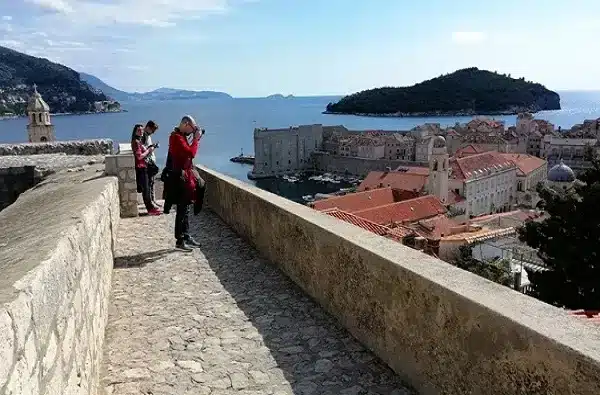Croatia Weather in January: A Detailed Overview
In January, Croatia experiences winter weather with temperatures varying across regions. Along the Adriatic coast, temperatures range from 5°C to 10°C during the day and drop to 0°C to 5°C at night. Inland regions see colder temperatures, often dipping below freezing.

When planning a trip to Croatia in January, it’s essential to understand the weather conditions to make the most of your experience. January falls within Croatia’s winter season, bringing cooler temperatures and varying weather patterns across the country.
Temperature in Croatia in January
In January, Croatia experiences winter temperatures, with variations depending on the region. Coastal areas generally have milder winters compared to inland regions.
- Coastal Areas: Temperatures along the Adriatic coast typically range from 5°C to 10°C (41°F to 50°F) during the day, dropping to around 0°C to 5°C (32°F to 41°F) at night.
- Inland Regions: Inland areas, such as Zagreb and Plitvice Lakes National Park, tend to be colder, with daytime temperatures ranging from 0°C to 5°C (32°F to 41°F) and nighttime temperatures often dipping below freezing.
Precipitation and Weather Patterns
Croatia weather in January is characterized by increased precipitation, including rain, snow, and occasional sleet. Coastal areas may experience more rain, while inland regions see snowfall, especially in higher elevations.
- Coastal Areas: Rainfall is more common along the coast, with occasional snowfall in northern coastal regions.
- Inland Regions: Inland areas, including Zagreb and central Croatia, experience snowfall, creating picturesque winter landscapes.
Is January a Good Time to Visit Croatia?
Whether January is a good time to visit Croatia depends on your preferences and travel objectives. Here are some factors to consider:
- Fewer Tourists: January is considered the offseason in Croatia, resulting in fewer crowds and lower accommodation prices. If you prefer quieter travel experiences and want to explore popular destinations without the crowds, January could be an ideal time to visit.
- Winter Activities: Despite cooler temperatures, Croatia offers various winter activities in January. From skiing in Gorski Kotar to exploring charming winter markets in Zagreb, there are plenty of opportunities for outdoor adventures and cultural experiences.
- Cultural Events: January hosts several cultural events and festivals across Croatia, providing insights into the country’s traditions and heritage. Attend winter festivals, concerts, and culinary events to immerse yourself in Croatian culture.
- Weather Considerations: While Croatia’s winter weather may not be as conducive to beach activities, it offers a unique ambiance for exploring historic cities, national parks, and scenic landscapes. Be prepared for colder temperatures and potential precipitation, and pack accordingly.
Is It Worth Visiting Croatia in Winter?
Visiting Croatia in winter offers a unique perspective on the country’s landscapes, culture, and traditions. While summer is the peak tourist season, winter provides opportunities for distinct experiences and fewer crowds.
Here are some reasons why visiting Croatia in winter can be worth it:
- Scenic Landscapes: Croatia’s winter landscapes, including snow-covered mountains, frozen lakes, and picturesque villages, offer stunning photo opportunities and outdoor adventures.
- Cultural Immersion: Winter festivals, traditional celebrations, and culinary events provide insights into Croatian culture and traditions. Explore local markets, sample winter delicacies, and participate in cultural activities to experience Croatia’s authentic charm.
- Outdoor Activities: From skiing and snowboarding in Gorski Kotar to ice skating in Zagreb’s city center, Croatia offers various outdoor activities during the winter months. Adventure enthusiasts can enjoy hiking, snowshoeing, and exploring national parks with fewer crowds.
- Affordable Travel: Off-season travel in Croatia often translates to lower accommodation prices, making it more budget-friendly for travelers. Take advantage of off-season discounts and deals to explore Croatia’s attractions without breaking the bank.
Is Dubrovnik Hot in January?
Dubrovnik, located along Croatia’s southern coast, experiences milder winter temperatures compared to inland regions but is not considered hot in January. Temperatures in Dubrovnik typically range from 10°C to 15°C (50°F to 59°F) during the day and can drop to around 5°C to 10°C (41°F to 50°F) at night. While not hot, Dubrovnik’s coastal location offers a pleasant environment for exploring its historic sites and coastal scenery.
Croatia Weather in January – Conclusion
While January brings cooler temperatures and increased precipitation to Croatia, it offers unique opportunities for travelers seeking winter experiences and cultural immersion. Whether you’re exploring historic cities, enjoying winter sports, or attending cultural events, Croatia’s diverse landscapes and rich heritage provide a memorable travel experience year-round. Consider the weather conditions, cultural events, and your preferences when planning a trip to Croatia in January, and embrace the beauty of winter in this enchanting destination.


